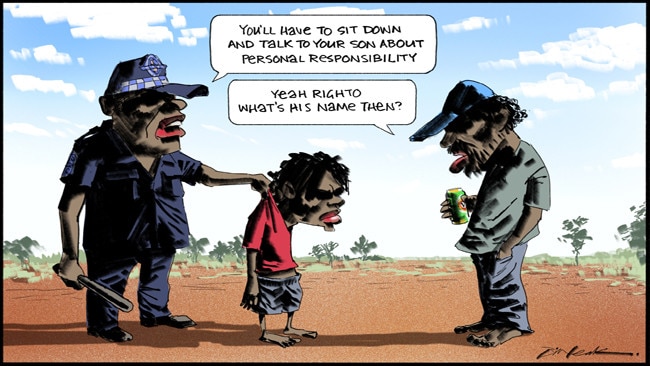Bill Leak cartoon reviewed for ‘racial hatred’
Bill Leak and The Australian are staring down a Human Rights Commission challenge under section 18C.

Bill Leak and The Australian are staring down a Human Rights Commission challenge under section 18C, 10 weeks after the cartoonist’s provocative drawing led to a public debate over indigenous parental neglect.
Commission president Gillian Triggs’s delegate, Jodie Ball, has written to the newspaper’s lawyers to advise that allegations of racial hatred under the Racial Discrimination Act will be investigated.
The allegations are in a complaint by Melissa Dinnison over Leak’s August 4 cartoon, which prompted widespread commendation and criticism for its blunt portrayal of a crisis in Aboriginal parenting.
In the cartoon, an indigenous uniformed Northern Territory police officer presents an indigenous youth to his father in an outback setting and says to the father: “You’ll have to sit down and talk to your son about personal responsibility.” The indigenous father, who is holding a can of Victoria Bitter beer, replies: “Yeah righto, what’s his name then?”
Those who supported the cartoon, including Aboriginal intellectuals and frontline workers, praised it for cutting through a miasma of political correctness to confront painful truths about a fundamental reason for the chronic neglect and abuse of indigenous children.
The cartoon’s loudest critics — including prominent media commentators and political philosopher and Race Discrimination Commissioner Tim Soutphommasane, who publicly called for racial hatred complaints — described Leak’s work as a racist and hateful smear of indigenous parents.
Attempts by The Weekend Australian to contact Ms Dinnison were unsuccessful. A north Queensland state school teacher by the same name said yesterday she was not the complainant.
Documents provided by the federal human rights body state Ms Dinnison has complained under section 18C because she says she has “experienced racial hatred” and been discriminated against as a result of the cartoon.
Her complaint states: “The Australian newspaper has published and endorsed a cartoon depicting racial discrimination, racial profiling, and racially offensive material. A series of cartoons illustrate hateful and derogatory material specifically relating to indigenous Australians, their relationships with their children, alcoholism and domestic violence.”
Ms Dinnison cites section 18C, which makes an act unlawful if it “is reasonably likely, in all the circumstances, to offend, insult, humiliate or intimidate another person or a group of people; and the act is done because of the race, colour or national or ethnic origin of the other person or of some or all of the people in the group”.
The Human Rights Commission has advised The Australian that “sections 18C, 18D and 18E of the Racial Discrimination Act appear relevant to the complaint”.
Ms Ball explained that when a complaint is received, Professor Triggs “is required to inquire into and attempt to resolve the complaint by conciliation”. The complaint is dated August 4 but the commission brought it to The Australian’s attention for the first time this month.
“If a complaint cannot be conciliated, or is terminated for some other reason, the person affected by the alleged discrimination may apply to the Federal Circuit Court of Australia for the court to decide the allegations,” Ms Ball said.
Leak and the newspaper have been given an October 28 deadline to respond to Ms Dinnison’s claims that “the publishing of the cartoon on August 4, 2016, constitutes racial hatred under the terms of 18C”, and to provide submissions “relevant to the commission’s consideration of the matter”.
The human rights body has also asked if Leak and the newspaper “would be willing to participate in a conciliation process to try to resolve the complaint”.
The relevance of section 18D of the Racial Discrimination Act is that it provides for a defence if the cartoon is found to have been published reasonably and in good faith “in the performance, exhibition or distribution of an artistic work; or in the course of any statement, publication, discussion or debate made or held for any genuine academic, artistic or scientific purpose or any other genuine purpose in the public interest”.
The defence can also be cited in making or publishing “a fair and accurate report of any event or matter of public interest; or a fair comment on any event or matter of public interest if the comment is an expression of a genuine belief held by the person making the comment”.
Professor Triggs and the commission are embroiled in another 18C case involving white students from the Queensland University of Technology who wrote Facebook posts about being kicked out of an indigenous-only computer room on the main Brisbane campus by a QUT staffer, Cindy Prior, in May 2013.
In that case, still before the Federal Circuit Court, Ms Prior, who is indigenous, seeks $250,000 in damages from the students, who strenuously deny racial hatred, and QUT.
The QUT case has led to Professor Triggs appointing independent Sydney lawyer Angus Stewart SC to run an investigation into counter-complaints by the students that their reputations and rights have been irreparably damaged by the commission’s allegedly incompetent and biased handling of Ms Prior’s complaint.
The editor-in-chief of The Australian, Paul Whittaker, said yesterday that freedom of expression was absolutely essential to a robust and fair-minded liberal democracy.
“Bill’s cartoons are often confronting and prompt readers to think about unpalatable truths,’’ he said. “In this case, it is an indisputable fact that the serious child welfare issues present in remote indigenous communities are often the result of absent or neglectful parents.’’
He said the newspaper was proud of Leak’s work and would mount a vigorous defence. He called on the Turnbull government to revisit previous Liberal Party promises to repeal or amend section 18C.
Leak said yesterday he was appalled that a government bureaucracy was permitted to intrude on and restrict one of the most fundamental freedoms in democracy, free speech, and was disgusted at the claims that he was a racist.
“This cartoon was about the plight of children in Aboriginal communities who wander the streets at all hours because they are too afraid to go their homes,” he said. “My sympathies are with these children and it is disgusting that when you try to draw attention to them, you are labelled a racist on social media and by the loud ‘anti-racists’ who are in fact the most racist of all. I am repulsed and repelled by racists and I have been all my life. Section 18C is an outrageous piece of law which leads to completely farcical situations like this.”
In the eruption of public debate over Leak’s cartoon, Mr Soutphommasane was quoted saying: “Our society shouldn’t endorse racial stereotyping of Aboriginal Australians or any other racial or ethnic group.”
The Race Discrimination Commissioner was accused of prejudging the issue. He made public statements that “a significant number” of people would agree the cartoon was a racial stereotype of Aboriginal Australians, and urged anyone offended to lodge a complaint under the Racial Discrimination Act.
The lawyer for two of the QUT students, Tony Morris QC, said The Australian had compelling defences for a cartoon he described as targeting not any one individual but “a caricature, both in an artistic and a substantive sense”.
“What is especially important is that the cartoon was intended to convey — and, I believe, was very successful in conveying — an important sociopolitical message: that the problems affecting youthful offenders in the Aboriginal community are sometimes contributed to by neglect on the part of their parents, and the absence of paternal role models. That may not be a fashionable or ‘politically correct’ opinion, but that does not make it wrong.
“I also deduce from Bill Leak’s published comments that it is an opinion honestly held, and based on his own life experience; and I expect that it would not be too hard to gather expert ... witnesses to support Leak’s opinion.’’
Ms Dinnison may be challenged to demonstrate that she could be a member of a “group of people” who “reasonably” take personal offence at Leak’s depiction of an unsophisticated outback male Aborigine.



